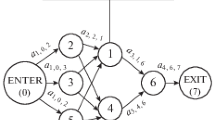Abstract
This article analyzes a tool switching problem arising in certain flexible manufacturing environments. A batch of jobs have to be successively processed on a single flexible machine. Each job requires a subset of tools, which have to be placed in the tool magazine of the machine before the job can be processed. The tool magazine has a limited capacity, and, in general, the number of tools needed to produce all the jobs exceeds this capacity. Hence, it is sometimes necessary to change tools between two jobs in a sequence. The problem is then to determine a job sequence and an associated sequence of loadings for the tool magazine, such that the total number of tool switches is minimized. This problem has been previously considered by several authors; it is here revisited, both from a theoretical and from a computational viewpoint. Basic results concerning the computational complexity of the problem are established. Several heuristics are proposed for its solution, and their performance is computationally assessed.
Similar content being viewed by others
References
Bard, J.F. and Feo, T.A., “The Cutting Path and Tool Selection Problem in Computer Aided Process Planning,”Journal of Manufacturing Systems, Vol. 8, No. 1, pp. 17–26 (1989).
Bard, J.F., “A Heuristic for Minimizing the Number of Tool Switches on a Flexible Machine,”IIE Transactions, Vol. 20, No. 4, pp. 382–391 (1988).
Bertossi, A.A., “The Edge Hamiltonian Path Problem is NP-Complete,”Information Processing Letters, Vol. 13, No. 4,5, pp. 157–159 (1981).
Blazewicz, J., Finke, G., Haupt, R. and Schmidt, G., “New Trends in Machine Scheduling,”European Journal of Operational Research, Vol. 37, pp. 303–317 (1988).
Booth, K.S. and Lueker, G.S., “Testing for the Consecutive Ones Property, Interval Graphs, and Graph Planarity Using PQ-Tree Algorithms,”Journal of Computer and System Sciences, Vol. 13, pp. 335–379 (1976).
Crama, Y., Kolen, A.W.J., Oerlemans, A.G. and Spieksma, F.C.R., “Minimizing the Number of Tool Switches on a Flexible Machine,” Research Memorandum RM 91.010, University of Limburg, Maastricht, The Netherlands (1991).
Daskin, M., Jones, P.C. and Lowe, T.J., “Rationalizing Tool Selection in a Flexible Manufacturing System for Sheet-Metal Products,”Operations Research, Vol. 38, No. 6, pp. 1104–1115 (1990).
Finke, G. and Kusiak, A., “Models for the Process Planning Problem in a Flexible Manufacturing System,”International Journal of Advanced Manufacturing Technology, Vol. 2, pp. 3–12 (1987).
Förster, H.-U. and Hirt, K., “Entwicklung einer Handlungsanleitung zur Gestaltung von Produktionsplanungs-und -Steuerungskonzepten beim Einsatz Flexibler Fertigungssysteme,” Schluβbericht zum Forschungsvorhaben, Nr. S 172, Forschungsinstitut für Rationalisierung, Rheinisch-Westfälischen Technischen Hochschule, Aachen (1989).
Fulkerson, D.R. and Gross, D.A., “Incidence Matrices and Interval Graphs,”Pacific Journal of Mathematics, Vol. 15, No. 3, pp. 835–855 (1965).
Golden, B.L. and Stewart, W.R., “Empirical Analysis of Heuristics,” inThe Traveling Salesman Problem, E.L. Lawler, J.K. Lenstra, A.H.G. Rinnooy Kan and D.B. Shmoys (eds.), John Wiley & Sons, Chichester, U.K., pp. 207–249 (1985).
Gray, A.E., Seidmann, A. and Stecke, K.E., “Tool Management in Automated Manufacturing: Operational Issues and Decision Problems,” Working Paper CMOM 88-03, Simon Graduate School of Business Administration, University of Rochester, Rochester, New York (1988).
Hirabayashi, R., Suzuki, H. and Tsuchiya, N., “Optimal Tool Module Design Problem for NC Machine Tools,”Journal of the Operations Research Society of Japan, Vol. 27, No. 3, pp. 205–228 (1984).
Hoffman, A.J., Kolen, A.W.J. and Sakarovitch, M., “Totally Balanced and Greedy Matrices,”SIAM Journal on Algebraic and Discrete Methods, Vol. 6, No. 4, pp. 721–730 (1985).
Johnson, D.S. and Papadimitriou, C.H., “Computational Complexity,” inThe Traveling Salesman Problem, E.L. Lawler, J.K. Lenstra, A.H.G. Rinnooy Kan and D.B. Shmoys (eds.), John Wiley & Sons, Chichester, U.K., pp. 37–85 (1985).
Kashiwabara, T. and Fujisawa, T., “NP-Completeness of the Problem of Finding a Minimum-Clique-Number Interval Graph Containing a Given Graph as a Subgraph,” inProceedings of the 1979 International Symposium on Circuits and Systems, pp. 657–660 (1979).
Kiran, A.S. and Krason, R.J., “Automated Tooling in a Flexible Manufacturing System,”Industrial Engineering, pp. 52–57 (April 1988).
Kou, L.T., “Polynomial Complete Consecutive Information Retrieval Problems,”SIAM Journal on Computing, Vol. 6, pp. 67–75 (1977).
Mattson, R., Gecsei, J., Slutz, D.R. and Traiger, I.L., “Evaluation Techniques for Storage Hierarchies,”IBM Systems Journal, Vol. 9, No. 2, pp. 78–117 (1970).
Möhring, R.H., “Graph Problems Related to Gate Matrix Layout and PLA Folding,” inComputational Graph Theory, G. Tinhofer et al. (eds.), Springer-Verlag, Wien, pp. 17–51 (1990).
Nemhauser, G.L. and Wolsey, L.A.,Integer and Combinatorial Optimization, John Wiley & Sons, New York (1988).
Roger, C., “La Gestion des Outils sur Machines à Commande Numérique,” Mémoire DEA de Recherche Opérationnelle, Mathématiques et Informatique de la Production, Université Joseph Fourier, Grenoble (1990).
Tang, C.S. and Denardo, E.V., “Models Arising from a Flexible Manufacturing Machine, Part I: Mimimization of the Number of Tool Switches,”Operations Research, Vol. 36, No. 5, pp. 767–777 (1988).
Volgenant, T. and Jonker, R., “A Branch and Bound Algorithm for the Symmetric Traveling Salesman Problem Based on 1-Tree Relaxation,”European Journal of Operational Research, Vol. 9, pp. 83–89 (1982).
Author information
Authors and Affiliations
Rights and permissions
About this article
Cite this article
Crama, Y., Kolen, A.W.J., Oerlemans, A.G. et al. Minimizing the number of tool switches on a flexible machine. Int J Flex Manuf Syst 6, 33–54 (1994). https://doi.org/10.1007/BF01324874
Issue Date:
DOI: https://doi.org/10.1007/BF01324874




